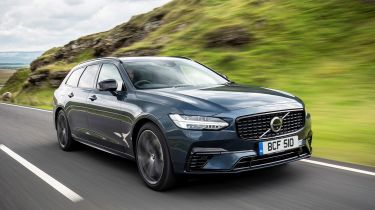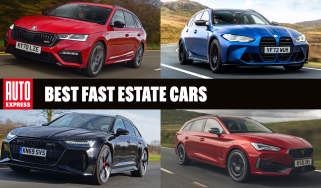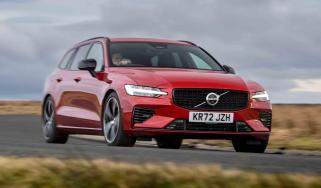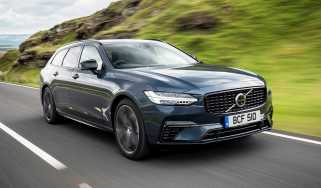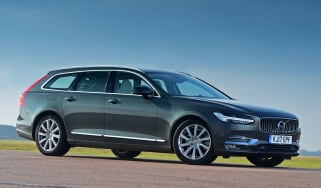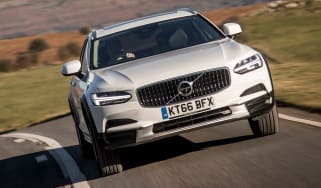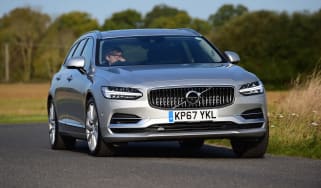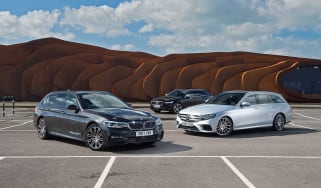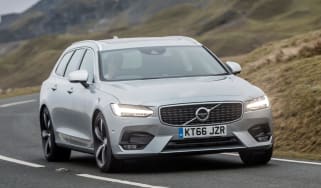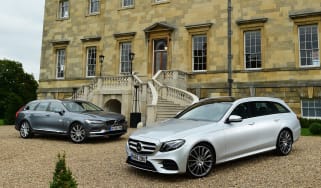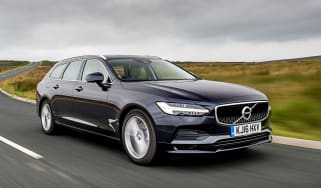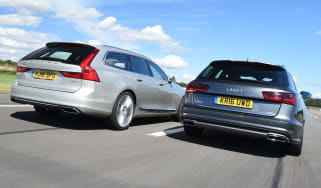Volvo V90 (2016-2025) review
The Volvo V90 isn't the biggest estate, but it has plenty of performance, a premium interior, and is very well-equipped

Just so you know, this is an older review of the 2016-2029 Volvo V90. If you are interested in information about a used Volvo V90, or news about the latest Volvo models, please follow the links provided.
Quick verdict
While the latest Volvo V90 estate is no longer the stand-out choice if you want the maximum amount of boot space, there’s still plenty to recommend it. It's practical enough and crammed with useful features, while its versatility combines with an eye-catching design, a classy and minimalist cabin, and a relaxed driving experience.
With the emphasis on comfort, the V90 is largely a pleasure on the road – as long as you don't expect handling to rival the best in class. The engine range has been slimmed to just two plug-in hybrid choices, and neither is lacking in performance. There’s no longer a diesel option for high-mileage drivers, putting it at a disadvantage against the Mercedes E-Class Estate. Still, it does manage to undercut plug-in hybrid versions of BMW 5 Series Touring and E-Class Estate on price, even though the V90 comes with more standard equipment.
Volvo V90: price, specs and rivals
Despite being briefly dropped from the line-up, the Volvo V90 estate is back, much like its smaller Volvo V60 sibling. Unlike the V60, you can only get the V90 in plug-in hybrid form, using powertrains from the V60 and the excellent Volvo XC90 SUV.
Used - available now
The real strengths of the V90 are its cabin and cruising refinement. The interior is roomy enough for four adults to take on long trips in and is superbly finished, with a clean and uncluttered fascia that’s easy to use. And on the move, the V90 is a refined cruiser, even when you’re pushing along at motorway speeds.
Volvo has a long history of producing big, practical estate cars, but the latest V90 sacrifices ultimate carrying capacity in favour of a more stylish exterior design. For instance, carrying a wardrobe will be a challenge thanks to its sloping rear tailgate.
However, as a plug-in hybrid estate, the V90 is less compromised by the location of its battery pack than the equivalent plug-in Mercedes E-Class Estate, which has a rather stingy 460-litre cargo area with the seats up compared with 551-litres in the Volvo. It can’t quite match the more generous 570 litres of space provided by the BMW 5 Series Touring, though.
The V90 engine range consists purely of plug-in hybrid power, and both T6 and T8 versions utilise the same size 18.8kWh battery (14.7kWh of which are usable), allowing for over 50 miles of electric range. As you’d anticipate, the T8 is the most potent, with 449bhp on tap versus 345bhp with the T6. Both come with four-wheel drive for added traction in slippery conditions.
The two trim levels are dictated by which engine you go for. Opt for the T6, and you’ll get Plus trim, while the T8 is reserved for Ultra. All trims come loaded with equipment, including a 360-degree camera system with parking sensors all around, heated seats front and rear, a heated steering wheel, adaptive cruise control, and a fancy 14-speaker, 600-watt Harman Kardon sound system. Of course, Ultra ups the ante with a 19-speaker 1,410-watt Bowers and Wilkins sound system, matrix LED headlights, adaptive suspension, a panoramic glass roof, and 20-inch alloy wheels.
Pricing for the V90 starts at nearly £60,000 for the T6 Plus version, undercutting the 5 Series Touring, while the top-of-the-range T8 Ultra is almost £67,500, which is a little higher than the starting price of the least expensive plug-in hybrid E-Class Estate.
Engines, performance and drive
Sensibly, the Volvo V90 has been developed to be a capable long-distance cruiser instead of something you’d want to throw around a Welsh B-road, and it has, for the most part, succeeded.
On a motorway, you should be pretty impressed by the V90’s ability to eat up long distances; both engines have enough punch to get you up to speed pretty quickly, and once you’re sitting at a fast cruise, they’ll fade away nicely into the background. Around town while utilising the electric motor, it’ll be even more refined than a traditionally powered petrol or diesel car.
The rest of the dynamic package is sensible and safe; the V90 stays stable and composed under braking, and while its steering is a little light, it is at least consistently weighted as you wind on lock.
If there’s a blot in the copybook, it’s ride quality. That’s not to say the V90 is particularly harsh or uncomfortable, it just isn’t quite as good at isolating you from sudden impacts with bumps as the Mercedes E-Class Estate. Choose the T8 Ultra which features adaptive dampers all-round and self-levelling air springs for the rear suspension, and it delivers a supple ride over bigger bumps, although sharp ridges and big potholes can catch it out and send a shudder through the cabin.
It’s still lovely to cover long distances in, because the dampers do a respectable job of maintaing composure, so it’s only big jolts and expansion joints at higher speed that affect comfort, lacking that final degree of finesse when compared with its rivals. There is a conventional suspension set-up on the T6 Plus, although we’re yet to try a V90 in this form.
Regardless of which engine you choose, you’ll end up with an eight-speed automatic transmission. There’s no manual gearbox, but you’re unlikely to miss it, because the auto has smooth and quick shifts. It does get caught out a little more frequently than the eight-speed automatic used by BMW, but not to the point where it’s an issue.
An arsenal of safety equipment – both active (which tries to stop the accident) and passive (which protects you when it’s happened) is available with the V90. Its features include large animal detection, which is designed to watch for creatures like elk and moose, but is also said to be capable of warning you when deer are at the side of a dark road in front of you.
The car also gets Volvo’s latest semi-autonomous technology, called Pilot Assist. You still need to keep your hands on the wheel to let the car know you’re ready to intervene, but do that and it’ll look after acceleration, braking and keeping the vehicle in the right lane. It works at speeds of up to 80mph, so it’s possible to use it on long journeys - though the real strength is in slow-moving or stop-start traffic on urban dual carriageways.
Engines, 0-60 acceleration and top speed
You couldn’t call the Volvo V90 slow, because even the entry-level T6 petrol plug-in serves up 345bhp and gets from 0-62mph in just 5.5 seconds, while the 449bhp T8 version cuts this down to 4.8 seconds. The top speed is limited to 112mph for all V90 variants.
Both plug-in hybrid versions accelerate faster than the BMW 5 Series Touring 530e or Mercedes E-Class Estate E 300 e, although the 5 Series and E-Class have higher top speeds.
MPG, CO2 and running costs
In keeping with the brand’s electrification objective, the Volvo V90 is plug-in hybrid only, which is a similar strategy to the latest BMW 5 Series Touring. On paper, the T6 has a combined fuel economy figure of 353.1mpg, while the more powerful T8 drops to 313.9mpg. Based on our experience with plug-in hybrids, you’re unlikely to get close to those figures in everyday driving, but regular charging should get you better fuel economy than a traditional petrol or diesel car.
The downside of only having plug-in hybrids is that higher mileage users who regularly drive long distances no longer have a diesel option to fulfil their needs. The only option would be to look at the Mercedes E-Class Estate, because not only do you have a choice of either four- or six-cylinder mild-hybrid diesels, but there’s also a plug-in hybrid diesel that’ll provide more electric range than the V90, plus better fuel economy when utilising the engine if you’re unable to charge the battery.
Electric range, battery life and charge time
Speaking of the battery, the 18.8kWh (14.7kWh useable) battery in the Volvo V90 affords an electric range of 54 miles in the T6 and 52.2 miles in the T8 version. Both numbers are beaten by the larger battery packs in the BMW 530e and Mercedes E 300 e, with ranges of 57.8 miles and 68 miles, respectively.
Charging up the battery from flat to fully charged using a typical 7.4kWh home wallbox charger will take around four hours with the V90, which is on par with rivals. Volvo offers a longer eight-year or 100,000-mile battery warranty with its plug-in than its rivals. You get a six-year/60,000-mile warranty from BMW, or a six-year/62,000-mile guarantee from Mercedes.
Tax
Business users might be interested in the benefits of running either the T6 or T8 plug-in petrol hybrids, because the low CO2 ratings (18g/km for the T6 and 20g/km for the T8) and over 50 miles of EV range gives a Benefit-in-Kind (BiK) rating of eight per cent, which is on par with its rivals. The only way of getting an estate with a lower BiK rating is to go for the fully electric BMW i5 Touring.
All versions of the V90 cost more than the £40,000 threshold for the supplementary luxury car tax, adding an additional surcharge from the second year the vehicle is taxed until it is six years old.
Insurance groups
Insurance for the Volvo V90 won't be particularly cheap due to all versions being powerful plug-in hybrids. The T6 starts in group 40, while the T8 is in group 41.
That’s on par with the BMW 5 Series Touring, but is less than the equivalent plug-in Mercedes E-Class Estate, which is in group 48 in E 300 e form.
Depreciation
Residual values for the Volvo V90 range stand up to its closest BMW and Mercedes rivals. Both the T6 Plus and T8 Ultra versions of V90 are expected to hold on to 50 per cent of their original value after three years or 36,000 miles. That’s slightly better than the 49 per cent of the BMW 5 Series Touring and is greater than the Mercedes E-Class Estate, which is predicted to maintain between 43 to 49 per cent over the same period.
To get an accurate valuation for a specific model, check out our free car valuation tool...
Interior, design and technology
The Volvo V90 is a departure from the firm’s traditionally boxy styling for estate cars, and despite having been on sale since 2017, the V90 can still be considered one of the best-looking estates on the market.
Many of the V90’s design features, such as the Thor’s Hammer running lights, imposing front grille and muscular shoulder line, are shared with other models in the Volvo range. The V90 gets a steeply raked tailgate that’s clearly intended to boost the car’s kerb appeal rather than improve practicality. The eye-catching vertical tail-lights that stretch from just above the bumper to the roof only enhance this impression.
For many buyers the sacrifice of space for style will be worth it, because the V90 is a real head-turner. Strong proportions and neat detailing combine to give the Volvo real presence. One free colour is available, along with four reasonably priced metallic alternatives.
Inside, the V90 builds on the dashboard architecture and material quality found in the Volvo XC90. Leather is standard on Plus trim, while Ultra has the £1,500 option of plusher Nappa leather. Quality is right up there with the best in the executive estate class, and while there are some harder, scratchier plastics to be found, they’re well hidden.
The highlight of the interior is the nine-inch touchscreen tablet. It has been improved over the years with different screen layouts and the integration of Google-based software. As a result, there are only a handful of buttons elsewhere on the facia, which helps give the car a minimalist look and feel. Elsewhere, light wooden veneers run the width of the interior and flow back on to the doors, while the hugely supportive multi-way adjustable seats are covered in soft leather.
Sat-nav, stereo and infotainment
The nine-inch tablet-style screen used in the Volvo V90 isn’t as big as the displays in a Mercedes or BMW, but the portrait orientation makes it less of an issue.
Everything is controlled by the touch-sensitive screen, so it’s similar to an iPad. It’s generally responsive – although it can sometimes lag behind your inputs. The screen looks sharp with clear graphics, plus the inclusion of Google software has improved certain features, namely the navigation, which works particularly well with voice commands to save you from having to manually input an address.
Android users will have to spend some time initially logging into the various apps they would use from their phone because there’s no Android Auto connectivity, while iPhone users can utilise a wired Apple CarPlay connection, it only displays across a small portion of the screen. Wireless phone charging isn’t provided on the V90, even as an option.
A standard 12.3-inch digital instrument cluster can be configured to show a sat-nav map with navigation instructions, which is useful while driving. Plus trim comes with an excellent 600-watt, 14-speaker Harman Kardon sound system, while the top-of-the-range Ultra uses a fancier Bowers & Wilkins stereo, which delivers a punchy sound thanks to its 1,400W amplifier and 19-speaker set-up, including a subwoofer.
Boot space, comfort & practicality
While the Volvo V90 doesn’t have the most capacity when compared with its big estate car competition, its plug-in hybrid system causes fewer compromises. That’s particularly telling if you look at the Mercedes E-Class Estate, which goes from a huge 615-litre boot in petrol and diesel forms, down to just 460 litres when specified as a plug-in hybrid like the V90.
That puts the 551-litre capacity of the V90 at an advantage over the Mercedes, although it can’t quite match the 570 litres of room in the BMW 5 Series Touring.
The steeply racked tailgate of the V90 impacts overall load volume when it comes to folding the back seats for a trip to the tip. At 1,517 litres, it comes up short against the 1,675-litre plug-in E-Class Estate and 1,700-litre 5 Series Touring.
Dimensions and size
The Volvo V90 is not a small car. At 4,945mm and 1,895mm wide (2,019mm including the mirror), the V90 is actually wider and only 4mm shorter than the far newer sixth-generation Mercedes E-Class Estate. It’s not quite as big as the enormous 5,060mm long BMW 5 Series Touring, which is also wider still at 1,900mm. If you have to parallel park often in town, the V90 might be the better of the three.
Seats, leg room, head room & passenger space
There’s decent room in the rear for three adults, although the middle seat is pretty thin and has less lateral support than the other pair. Two grown-ups will have more than enough space in the outer positions, though, and headroom is decent in the front and rear.
The tapering roofline makes it a little darker in the rear cabin, and it also means that while front passengers can get in and out easily, taller rear occupants may need to dip their heads slightly as they jump aboard. It’s far from an awkward squeeze, though, and you may not even notice it unless you’ve had lots of experience travelling in other large estate cars.
There are two ISOFIX points on the outermost rear seats, and they are relatively easy to access; you simply flip up or remove plastic tabs covering the mounting hooks, so you don’t have to worry about your seat chassis snagging on the base of the seat back.
Boot space
While the Volvo V90 isn't the largest estate in the class, but the load bay should be big enough for most users. With the rear seats in place, there are 551 litres on offer – and with them lowered, the capacity extends to 1,517 litres.
By comparison, the BMW 5 Series Touring has a 570-litre boot that extends to 1,700 litres when the seats are folded down. Unfortunately, the plug-in hybrid system used in the Mercedes E-Class Estate compromises its practicality, providing only 460-litres with the seats up. Things do improve with the seats down, with its 1,675-litre boot offering nearly 160 litres over the V90.
At least the load area in the Volvo is still a useful space with some neat touches. There’s a flat floor that helps when sliding in big loads, plus there are conveniently placed handles to drop the rear seats without having to open the back doors. There’s also a fold up flap you can strap shopping bags to and prevent them sliding around. We also approve of the gas struts that support the lid when accessing the underfloor storage area. Keyless entry and a powered tailgate also feature.
Towing
Both versions of the Volvo V90 are capable of towing a braked trailer or caravan of up to 2,100kg, and the standard four-wheel drive system will be useful on wet grass when you need additional traction.
The BMW 5 Series 530e is also capable of towing this amount, while the petrol plug-in hybrid E 300 e Mercedes E-Class Estate can only tackle 1,800kg. You’d need to look at the diesel plug-in hybrid E 300 de in order to get a hybrid E-Class that’s just as capable as the V90.
Reliability and safety
There’s lots of safety technology inside the Volvo V90 to try and prevent a crash from happening in the first place. All versions come with Pilot Assist, which includes lane centering on the motorway, and blind spot monitoring to warn and prevent you from colliding with a vehicle alongside you when changing lanes on a motorway or dual carriageway. There’s also adaptive cruise control with a stop and go function in traffic, and a speed recognition system.
However, while the V90 did receive the maximum five out of five star rating by safety experts Euro NCAP back in 2017, that rating is no longer valid. That doesn’t mean the V90 won’t still protect you well in a collision, it just means comparisons can’t be drawn between the five-star scores of the latest BMW 5 Series Touring or Mercedes E-Class Estate received in 2023 and 2024, respectively, because the test has become much more stringent in the intervening years.
There’s more rosy news in terms of the brand’s 2024 Driver Power customer satisfaction score. While the V90 didn't feature in the survey, the brand achieved 16th place out of 32 manufacturers, which was ahead of Mercedes in 25th place, and just behind BMW in 14th. Owners praised front seat comfort, rear leg room, and interior style and quality. Misses included high running costs, powertrains, and ownership satisfaction.
Warranty
All Volvos come with a three-year/60,000-mile warranty, which is standard for the class, although BMW and Mercedes offer a similar three-year warranty without a mileage limit. The main warranty can be extended for a fee to either four years/60,000 miles, or four years/80,000 miles, whichever comes soonest.
In addition, Volvo issues a paint warranty for the same three years, while a corrosion warranty covers the car for twelve years.
Servicing
The Volvo V90 requires servicing annually or every 18,000 miles, whichever comes first.
A Volvo Service Plan can be set up to help customers spread servicing costs on an interest-free monthly basis.
More reviews
Car group tests
In-depth reviews
Used car tests
Which Is Best
Most Economical
- Name2.0 T6 [350] PHEV Plus Dark 5dr AWD Auto
- Gearbox typeSemi-auto
- RRP£62,890

